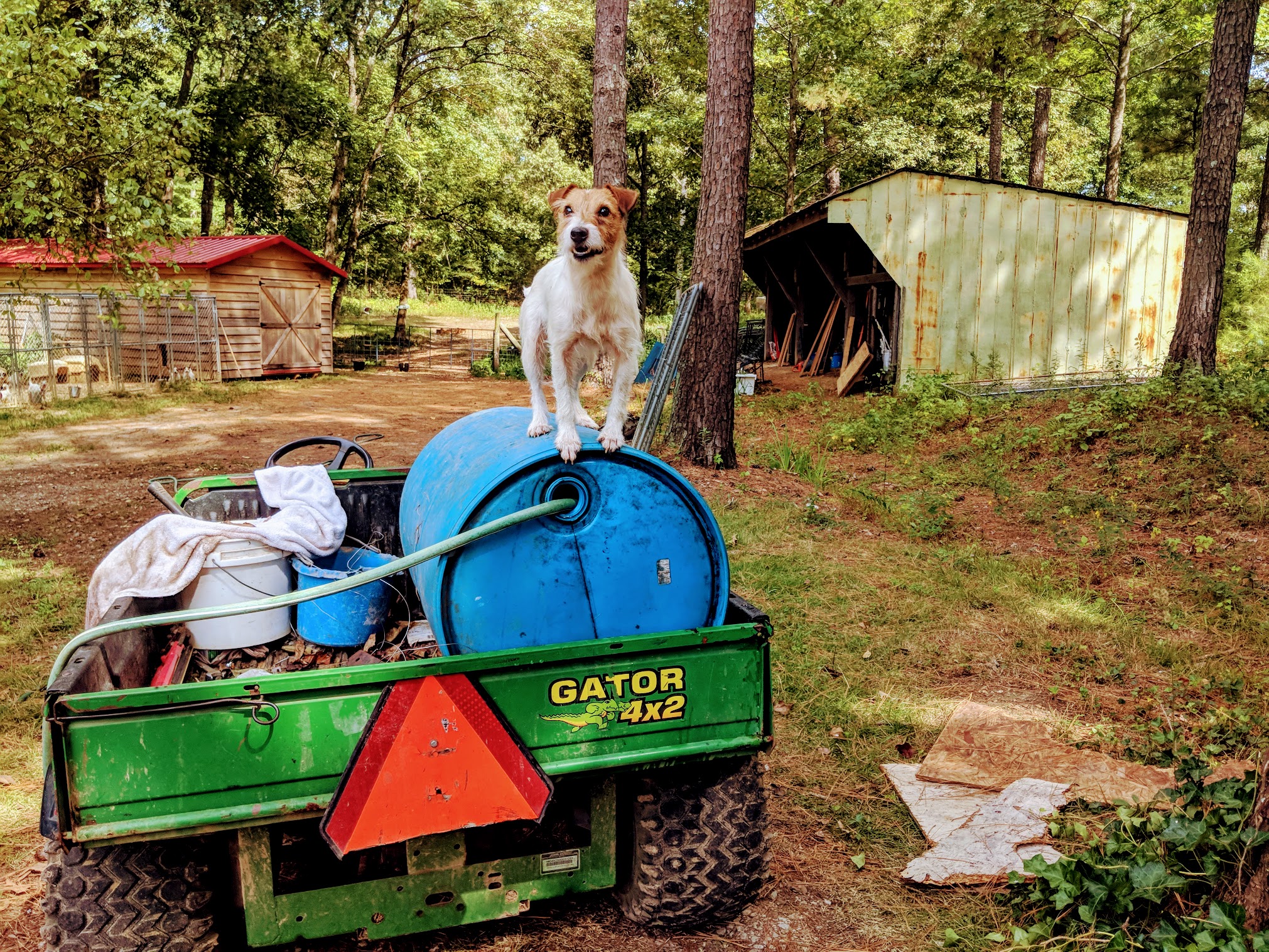On September 9, the Sierra Nevada Scent Work Club will be hosting an AKC Farm Dog Certified test in Reno, NV. The Farm Dog Certified test is designed to evaluate a dog’s manners in a farm or ranch setting through twelve simulated farm exercises, such as approaching livestock or waiting at gates. Testing isn’t only appropriate for dogs living on farms. Many dog sport events are held on farms and ranches, meaning dogs from virtually any background may find themselves in the presence of livestock or farm equipment at one point or another in their dog sport career. Whether we are visiting family or have the opportunity to visit a ranch, we also want our dogs to be welcome too. The Farm Dog Certified test is a neat way to demonstrate those skills.
So how does the Farm Dog Certified test measure up with reality? Well, let’s see!
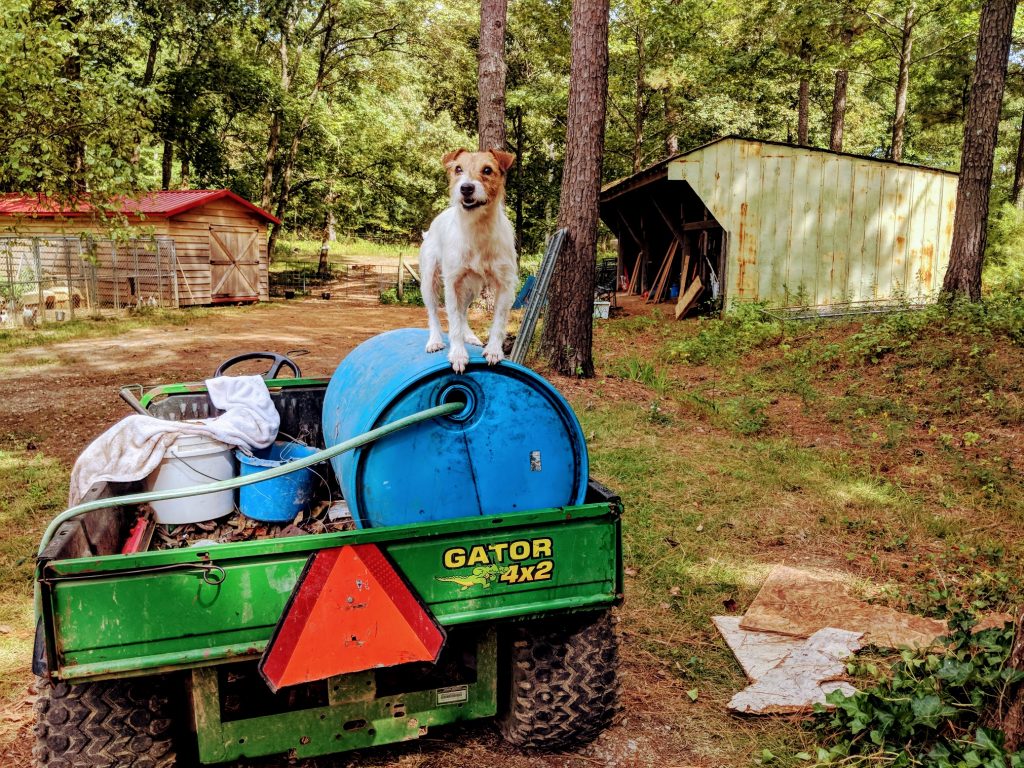
This is Liam, a four-year-old Parson Russell Terrier. Liam, along with my other dogs (and the rats too!) are on vacation this week in Tennessee. A real vacation, where I’m doing a bit of office work and coordinating lesson plans but otherwise sightseeing, visiting with friends, getting sleep and move of all enjoying time with my dogs in this beautiful place. My vacation has brought me to a friend’s lovely farm where I am farm sitting while she is enjoying a much-needed vacation of her own. Before you start yelling that this is somehow work, I really do consider farm sitting vacation. Being among the critters, following the routine, enjoying the sounds and smells, hanging out with my dogs – all many, many miles from the nearest coffee shop – that is vacation. But I digress.
Liam accompanied me on today’s farm chores. Why? Does he herd sheep or water ponies? No. We enjoy each other’s company and like to do things together. It’s that simple. I enjoy doing things with my dogs and generally speaking, my dogs enjoy doing things with me including farm chores.
Now, before you embark on today’s chores with me, consider this the “don’t try this at home” part of the lesson: Liam may not live on a farm, but we have trained both directly and indirectly with livestock because we frequent farms and ranches for competition, training, social gatherings and vacations like this. You are likely to notice that Liam is not wearing a lead for most chores and you would be correct. This is a real farm and not a test. Liam has excellent manners and a phenomenal recall even around livestock and small animals. He’s not demonstrating test items but rather providing a practical example of test items in the real world. Always use good judgment around livestock, with or without your dog. As the human in the equation, your role is to keep everyone safe – including yourself.
Now on to Liz and Liam’s Adventure in Farm Chores, the Tennessee Edition.
TEST ITEM 1: GREET JUDGE – INITIAL DOG APPRAISAL
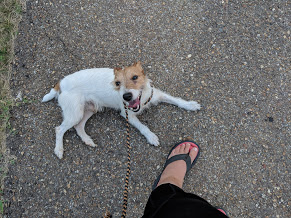 The handler approaches the Judge with the dog at side on a loose lead. The dog may stand, sit or down at the handler’s side on a loose lead while the Judge performs introduction. Skills Demonstrated: Ability of the dog to demonstrate patience and self-control while meeting a friendly stranger.
The handler approaches the Judge with the dog at side on a loose lead. The dog may stand, sit or down at the handler’s side on a loose lead while the Judge performs introduction. Skills Demonstrated: Ability of the dog to demonstrate patience and self-control while meeting a friendly stranger.
The only people judging my dog on the farm are me, the property owners when they are home and anyone who happens to drop by which in a rural community may be quite often – particularly when the neighbors have been warned that the city slicker dog trainer is hanging out at the farm. Fair enough. This afternoon, Liam and I headed down the driveway to pick up the mail and met up with one of the neighbors happening by in his horse drawn buggy. While we had a good chat (and honestly a good laugh over the fact that no one had yet seen me running down the main drag chasing over a flock of sheep), Liam laid down and waited politely. (Hey look, there’s a leash!)
TEST 2: PERFORM A WALKING PATTERN AROUND FARM ENVIRONMENT / PASSIVE STRANGER
The handler walks the dog on a loose lead through a prescribed pattern (minimum of 200 feet) around a number of objects. As the facility permits – the marked path should guide the handler and the dog safely around farm equipment, through barn aisles, by stacks of feed, etc. A passive stranger should be sitting quietly approximately 20 feet away from the path of the dog. Livestock and gates should be avoided at this stage. The dog must remain on a loose lead, and willingly follow the handler throughout the pattern. Skills Demonstrated: Ability of the dog to demonstrate self-control, responsiveness to the handler, and ability to adapt to an unfamiliar environment.
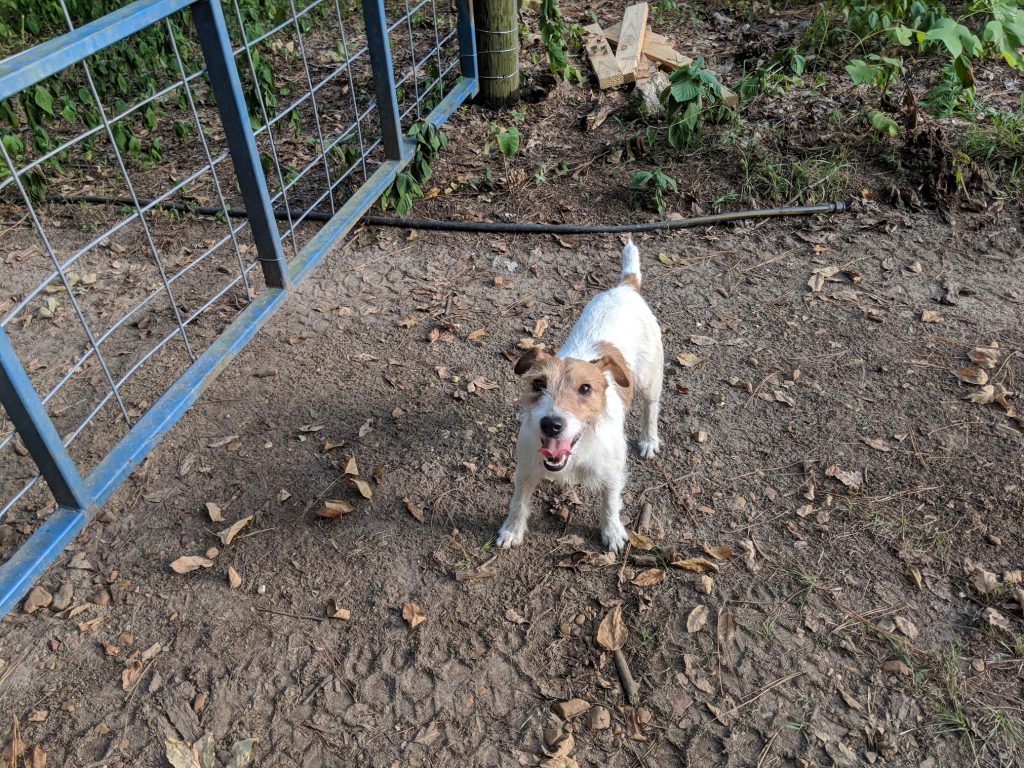
Walking…waiting…walking…waiting.
Farm chores generally involve two forms of transportation around here: my feet or the Gator. In either case, the route involves passing the pump house, maybe stopping in at the equipment shed, going through various gates, traversing pastures and traveling in and out of the barn. It’s a farm and it is filled with farmy things like water troughs, feed troughs, feed sacks, machinery, buckets, tack. If it’s farm related, it’s probably here because we are after all on a farm. No matter which path we take, Liam is happy to come along and does not impede my progress but enhances my enthusiasm.
TEST 3: JUMP ON HAY/STRAW BALE
The handler approaches a hay/straw bale or a safe pile of sacks of grain/feed with the dog on a loose lead and instructs the dog to jump up on the bale of hay. The dog may stand, sit or down until the Judge instructs the handler to allow the dog to jump off of the hay bale. The Judge shall determine length of stay (minimum of 10 seconds) until satisfied that the dog is comfortable with the exercise. Skills Demonstrated: Ability of the dog to exhibit obedience to the handler, traverse varying terrain on farms, and athletic ability to be positioned as needed.
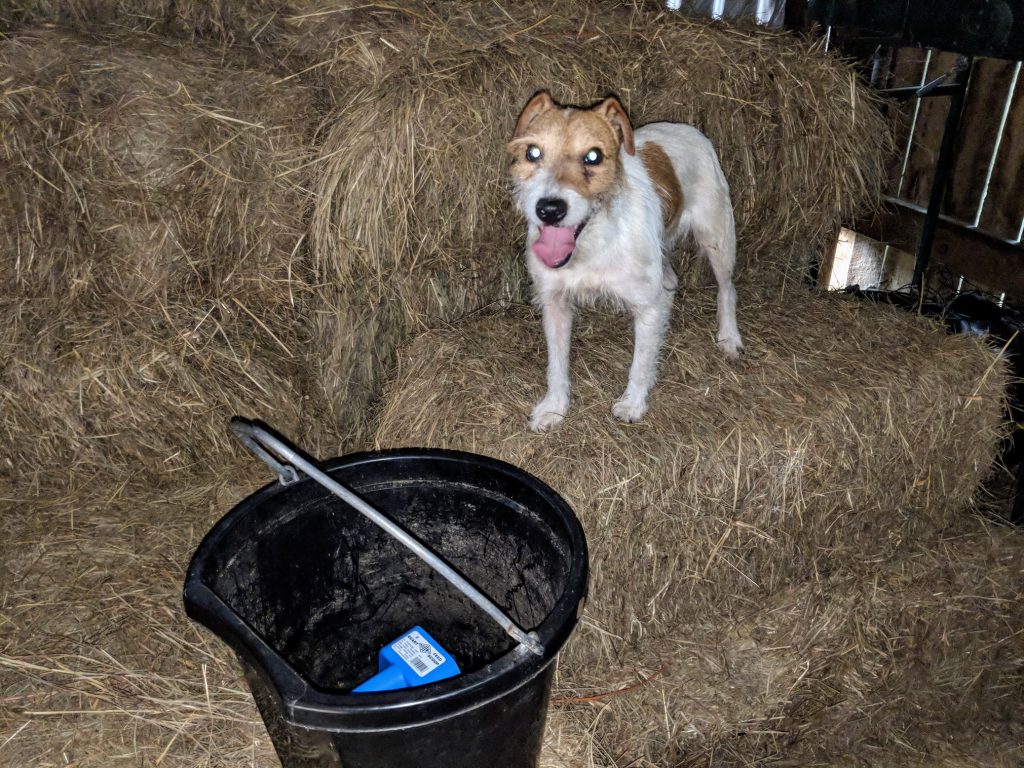
It could be straw. It could be feed bags. It could be the tailgate of the Gator while I water the ponies. There are times when I just need Liam to hang out exactly where I put him while I do something else, such as back up the Gator to a water trough (no running over terriers, thank you very much) or righting a fallen feed trough in a mob of hungry sheep (they are surprisingly pushy creatures). I did ask him to wait on a hay bale just for you all, so I knew where he was while I was in the feed room scooping grain for everyone. I think he was hoping a mouse might run through.
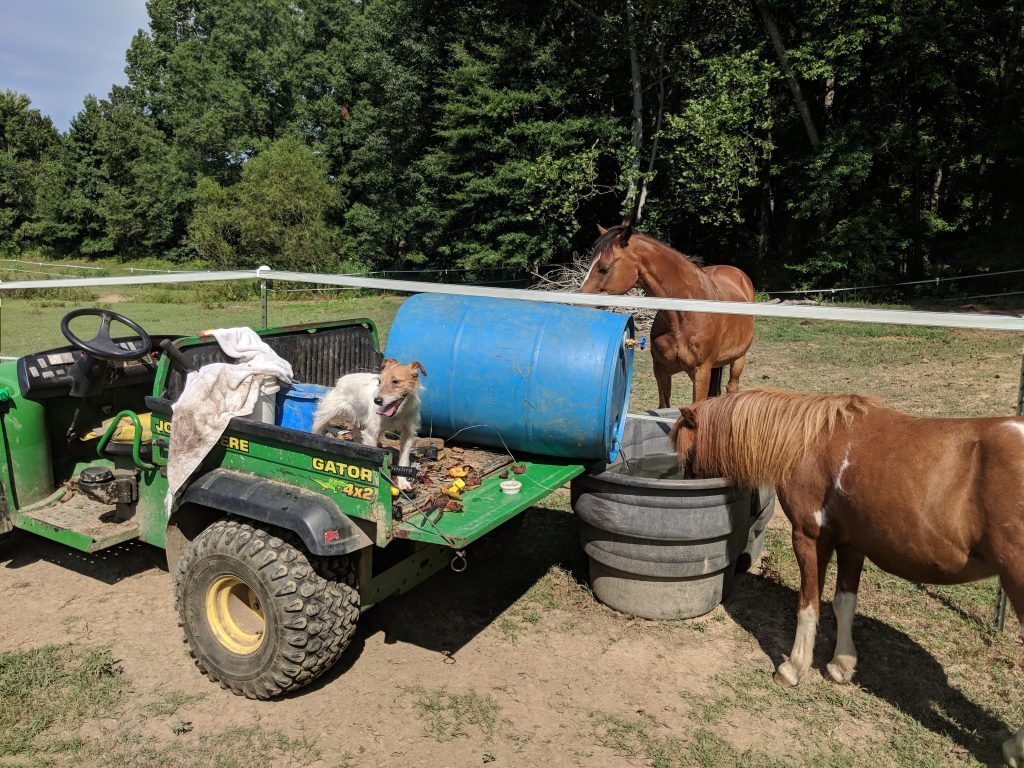
Helping to water beasties, or more accurately staying safe and out of the way in the back of the gator while I water beasties.
TEST 4: WALK BY FARM ANIMALS
The handler walks the dog on a loose lead in view of penned farm animal(s) approximately 30 feet away from the fence line housing the farm animals. The dog is not expected or encouraged to engage with livestock and should pay no undue attention to the animal(s) at this distance. Any animal routinely found on a farm is suitable, cow, pig, sheep, horse, chickens, ducks etc. All livestock must be penned or fenced in a manner to ensure safety from any uncontrolled dogs. Allows for the Judge to evaluate the dog’s initial response to livestock. Skills Demonstrated: Ability of the dog to demonstrate self-control, responsiveness to the handler, and ability to not disturb livestock.
Fun fact: Unless your dog is present to manage the livestock in some way, your dog needs to not chase or harass livestock. Farm animals are exciting. They smell great. They make great noises. They sometimes run and behave like the prey animals they may be. The stock in front of you is likely your livelihood or someone else’s livelihood. Friends don’t let dogs harass livestock. As a terrier, Liam was not born understanding that he should attempt to take down a sheep, but we have trained for this. He’s calm and under threshold, meaning he can think and quickly respond to cues. We’re just out for a walk…with some sheep.
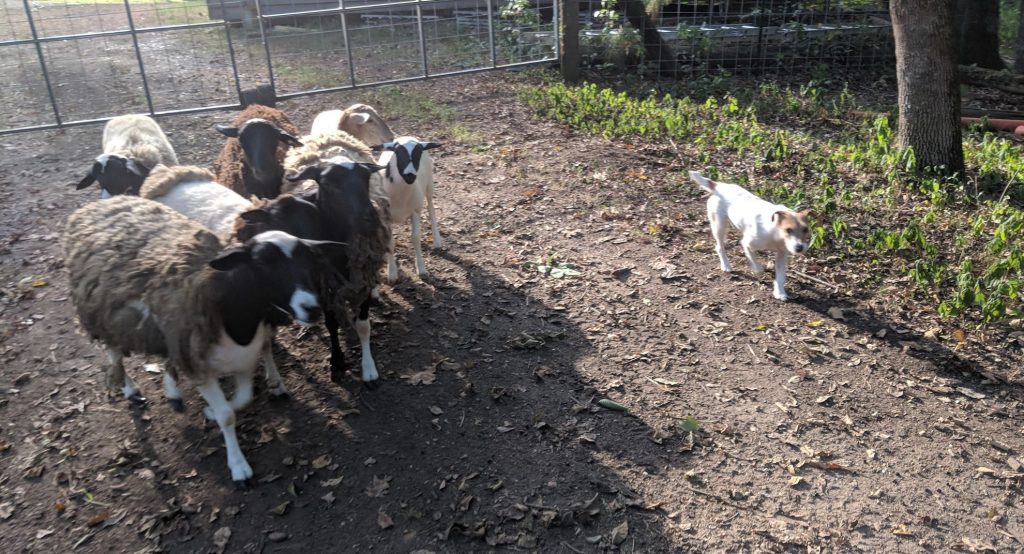
Just a terrier walking along with some sheep. Nothing to see here.
TEST 5: WALK OVER OR THROUGH UNUSUAL SURFACES
The handler walks the dog over or through three different unusual surfaces. One surface shall be a piece of plastic that is a minimum of 8 feet long and 4 feet wide, such as a polyethylene tarp or clear plastic in good condition. A second surface shall be a wood surface that is a minimum of 8 feet long and 4 feet wide, such as a sheet of plywood or wood flooring that is lying flat on the ground. A third option shall represent typical rural terrain and can include such examples as safe metal or wire grating lying flat on the ground, mud, water, or jump over a series of three logs that are a minimum 4” diameter which are placed 3 feet apart. If mud or water is used, the dog, at a minimum, must place all four feet in the mud/water. Surfaces should not present any risk of injury to the dog or handler. Skills Demonstrated: Demonstrates that the dog is fit to walk on different surfaces and to willingly accompany the handler on a loose lead to any places necessary to perform chores on a farm.
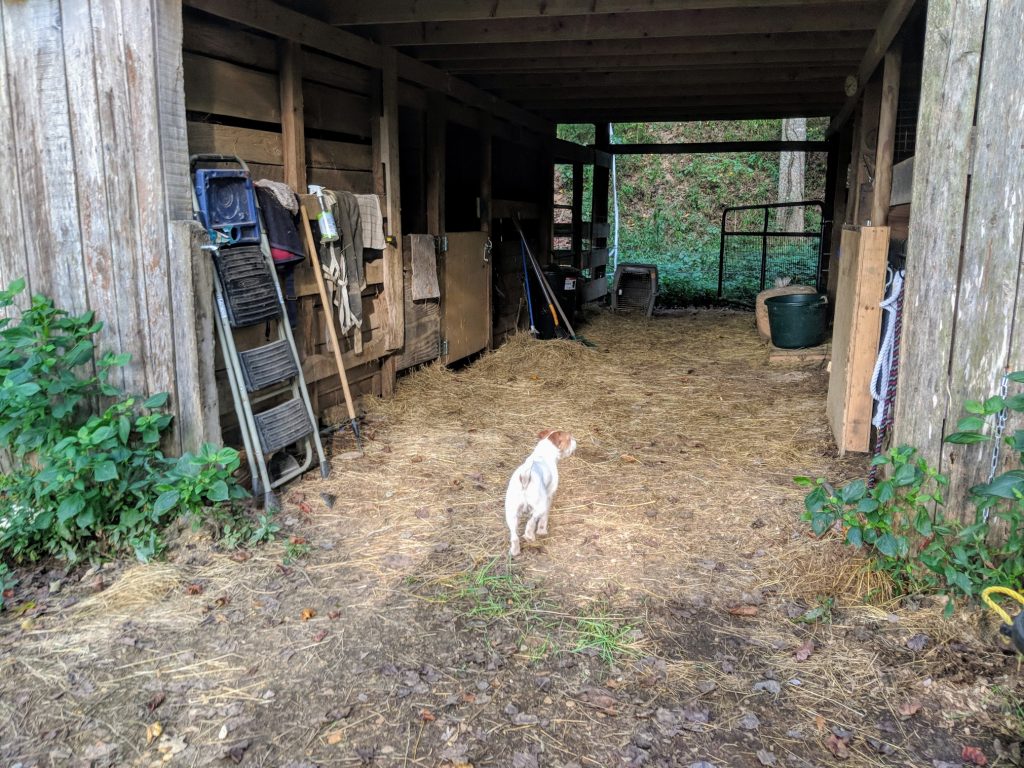
This is one of those test items that related not only to farm life but everyday life. Liam negotiated the following surfaces in our chores this evening: wood planks, railroad ties, gravel, asphalt, plywood, straw, grass, dirt, metal and feed sacks to name a few. He trusts that I won’t ask him to do something unsafe and I trust that he will come along wherever we go.
TEST 6: SUPERVISED SEPARATION
The handler places the dog in a free standing kennel or dog crate, removes the leash and walks out of sight for a minimum of 2 minutes. The dog may move around within the space allotted but should not continually bark, whine, or pace unnecessarily, or exhibit any behavior greater than mild agitation or nervousness. Skills Demonstrated: Demonstrates that the dog can be confined temporarily as needed, and will maintain training and good manners out of sight of the handler.
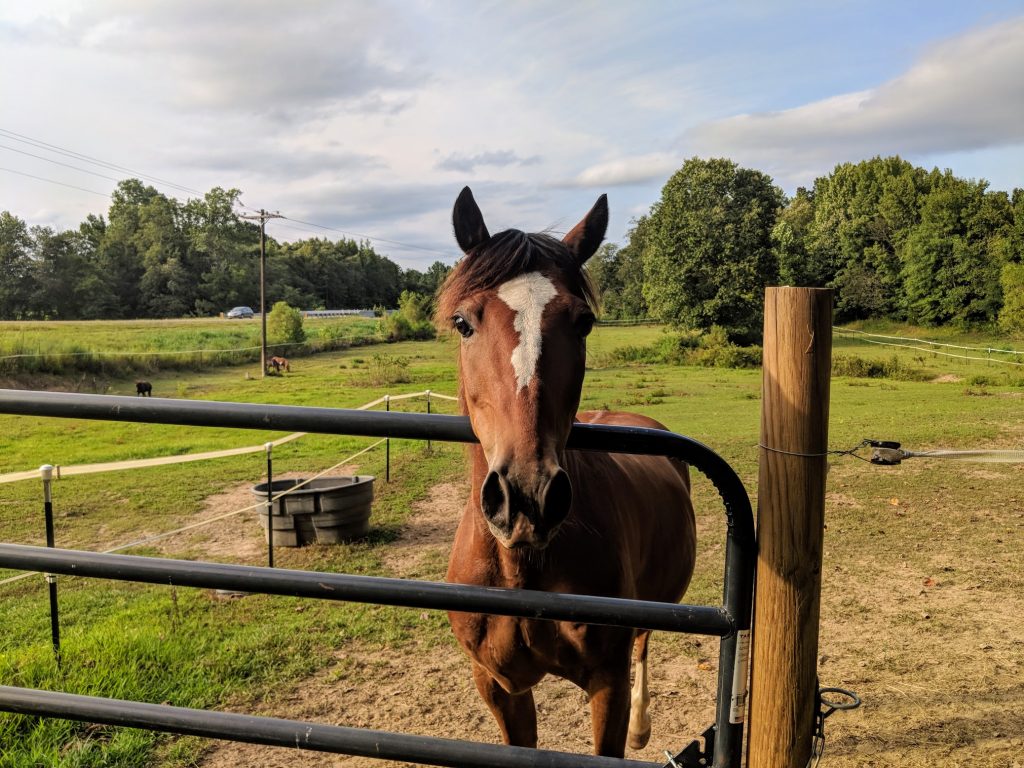
In lieu of photos of Liam kenneled, please enjoy Wilbur.
There is nothing worse than trying to do chores with a dog barking at you in her kennel run. I’m not naming names but BLADE, we seriously need to work on this. Liam, on the other hand, hung out quietly in a kennel for about 45 minutes while I cared for the resident dogs. Take note, Blade!
TEST 7: PASS THROUGH A GATE
The handler approaches a designated gate with the dog on a lead. The handler instructs the dog to stay in position while the handler opens the gate (the dog may stand, sit or down). The handler opens the gate away from the dog, passes through and calls the dog through the gateway. The handler then instructs the dog to stay as the gate is closed. At no time should the dog impede the handler in opening and closing the gate. The gate should function properly, be simple to operate, and present no safety hazard to the dog or the handler. Skills Demonstrated: Ability of the dog to demonstrate self-control and basic obedience to not interfere with necessary task of the handler.
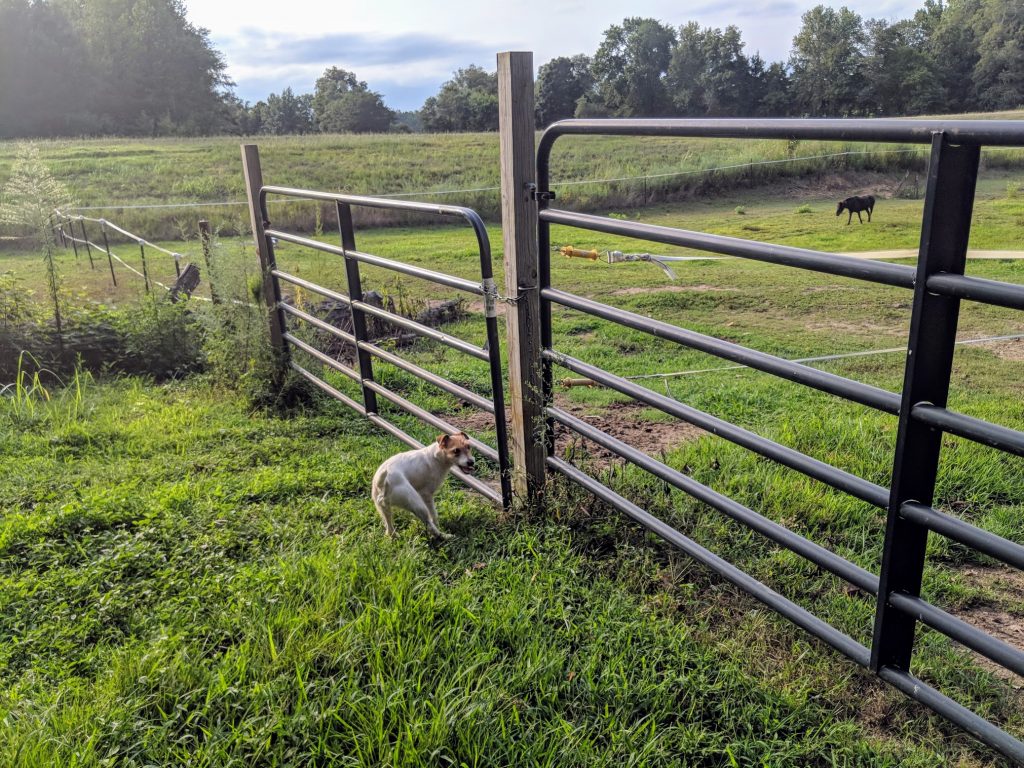
Liam is waiting at gates he can clearly walk through. I want my dogs to wait at gates until I get there.
Sometimes I pass through gates empty handed but often, I am carrying something (like a feed bucket) or need two hands to disable an electric fence or open a gate. Most often, I am paying attention to the livestock on the other side because while I did indeed play Crate Games with Dorothy the Ewe today, accidentally releasing livestock into the wild is not part of the gig. This means that my focus needs to not be on an unruly dog that wants to rush through gates, particularly toward stock. This also means respecting fencing even if it is simply electric tape. Liam waits until I cue him to move through or release him to come with me away from the area. I am not facing him and repeating, “Wait. Wait. WAAAAAITTTT!” I cue the wait and do what I need to do, like shake my hand like an idiot because I bumped the electric tape again. I am not graceful. Fortunately, Liam is. Here is an overly dramatized video for your viewing pleasure:
Side Story: Five years ago, on my first long visit to Tennessee, I hosted a Barn Hunt trial on a beautiful horse farm that used a single line of electric tape to keep horses in. Folks came from all over, including urban areas. Despite our repeated warnings and a sign asking exhibitors not to touch the electric fence, one exhibitor did just that. You know, to see what would happen. She was very surprised by the result. Here’s the thing – if you see a 1,400 lb animal behind a gossamer ribbon, there is probably a reason it’s staying there. Incidentally, I have run into the tape twice this trip with the gate chain. But I digress. Respecting boundaries isn’t just for dogs, it’s for people.
TEST 8: HANDLER FEEDS LIVESTOCK
The handler performs a farm chore of feeding farm animals. At no time will the handler or the dog enter an enclosure or have direct contact with the animals(s). All feeding of livestock shall be over or through a fence or enclosure. The handler approaches the animal enclosure with the dog at side on a loose lead. Approximately 30 feet from the enclosure, the handler ties/stakes the dog in a designated area. The dog must be wearing a secure, flat collar. The handler instructs the dog to stay and proceeds to complete the chore of feeding the animals before returning to the dog. Skills Demonstrated: Ability of the dog to be tied and remain calm while the handler performs the task of interacting with livestock. Establishes foundation for the dog to be trusted around livestock.
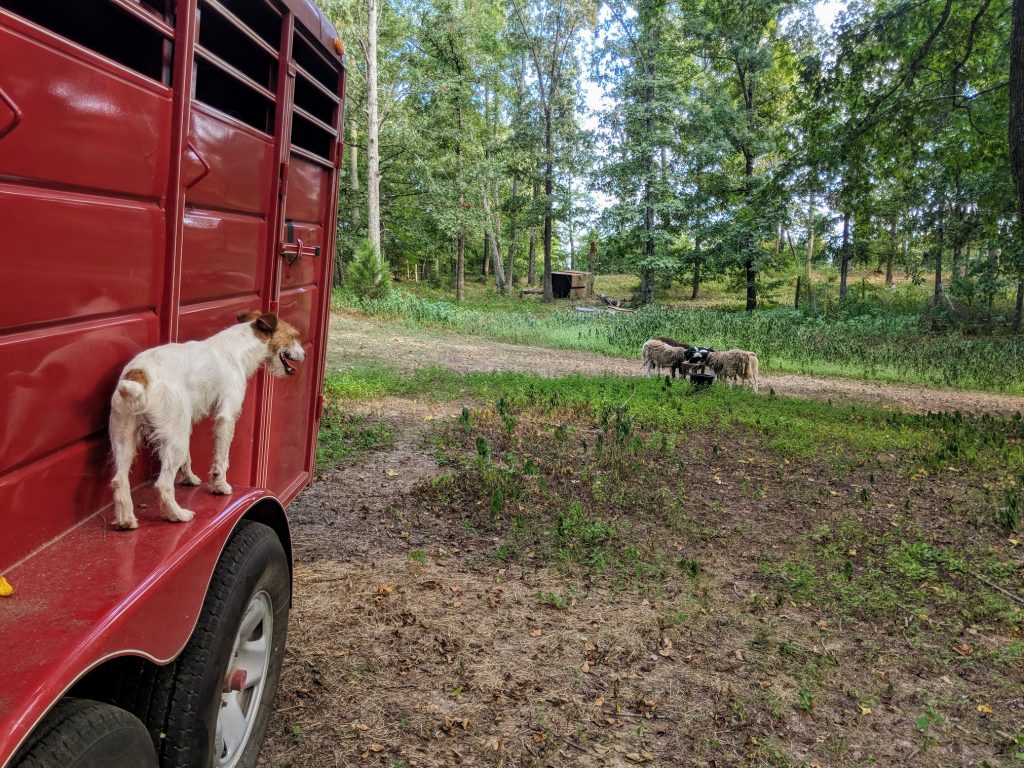
Waiting while I feed the sheep.
As established in the story above, there is generally livestock on a farm or ranch and as humans, we’re going to interact with said stock, including feeding, watering, saying hello, checking on their wellbeing, etc. Although the test doesn’t have the handler going through the gate to feed livestock, I am. There are some individuals I feed where Liam is welcome while others want nothing to do with him or it may be dangerous for him to come in. In all cases, Liam keeps his cool while I dole out food to the ponies and sheep.
TEST 9: REACTION TO ANOTHER DOG
The handler is positioned in a designated area with the dog at side on a loose lead. The dog may stand, down or sit. Another dog is walked by twice on lead approximately 10 feet away. The first time the distraction dog is walked by on the side of its handler that is away from the dog being tested. The distraction dog and handler will then reverse direction and pass with the distraction dog on the side toward the dog being tested. While acceptable to notice the other dog, the tested dog should be accepting of the other dog and not appear to be unduly distracted. The tested dog must remain on a loose lead and show no fear or aggression toward the passing dog. Skills Demonstrated: Ability of the dog to exhibit self-control and acceptance of other, non-threatening, dogs working on the farm property.
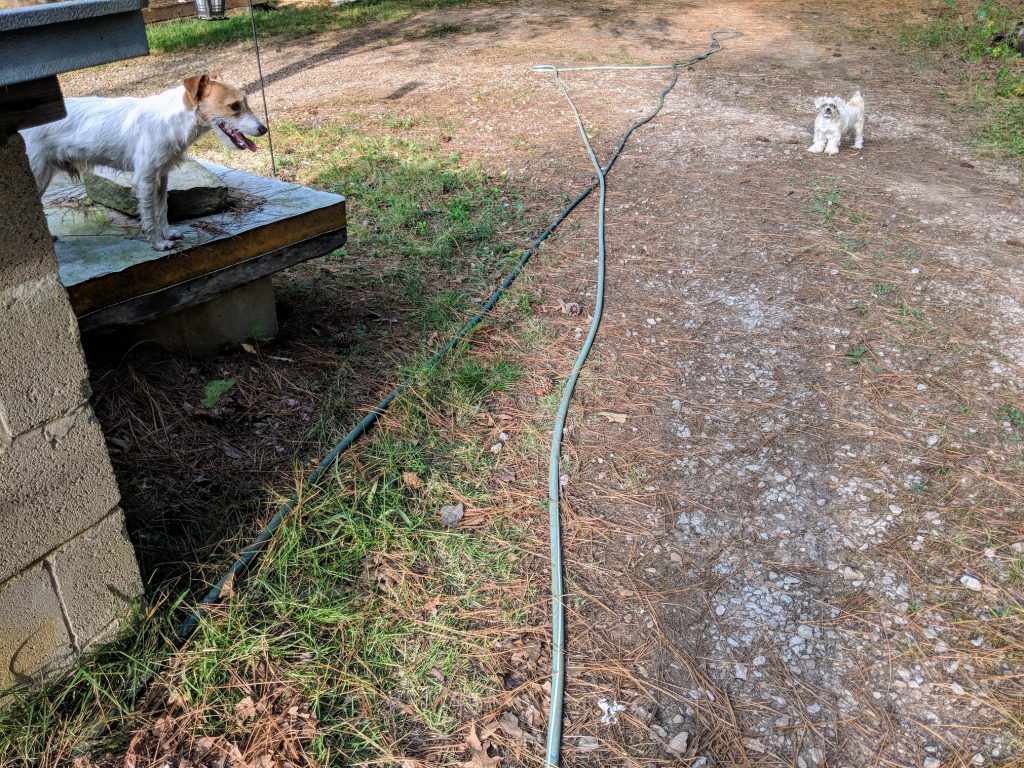
The job today is not harassing Daisy, the resident Shih Tzu who can do as she pleases. The job is also not to harass resident dogs in their run outs. Further, the job is not to run down sheep, ponies, chickens, geese, buggies or whatever happens to be out there. Liam’s job is to hang out and not bug the residents and he did an excellent job of it. See all the previous test items.
TEST 10: REACTION TO NOISE DISTRACTION
The handler may stand or quietly walk in a designated area with the dog at side on a loose lead. The assistant creates two background noises typical to a working farm environment. Noise distractions can consist of any common farm sound, such as hammering nails, sawing wood, leaf blower, farm machine starting up, lawn mower, chain saw, air compressors, etc. The tested dog must remain on a loose lead, and exhibit no excessive fear or sensitivity to the background noise. Skills Demonstrated: Ability of the dog to demonstrate normal sensitivity to typical noises of everyday life on a farm.
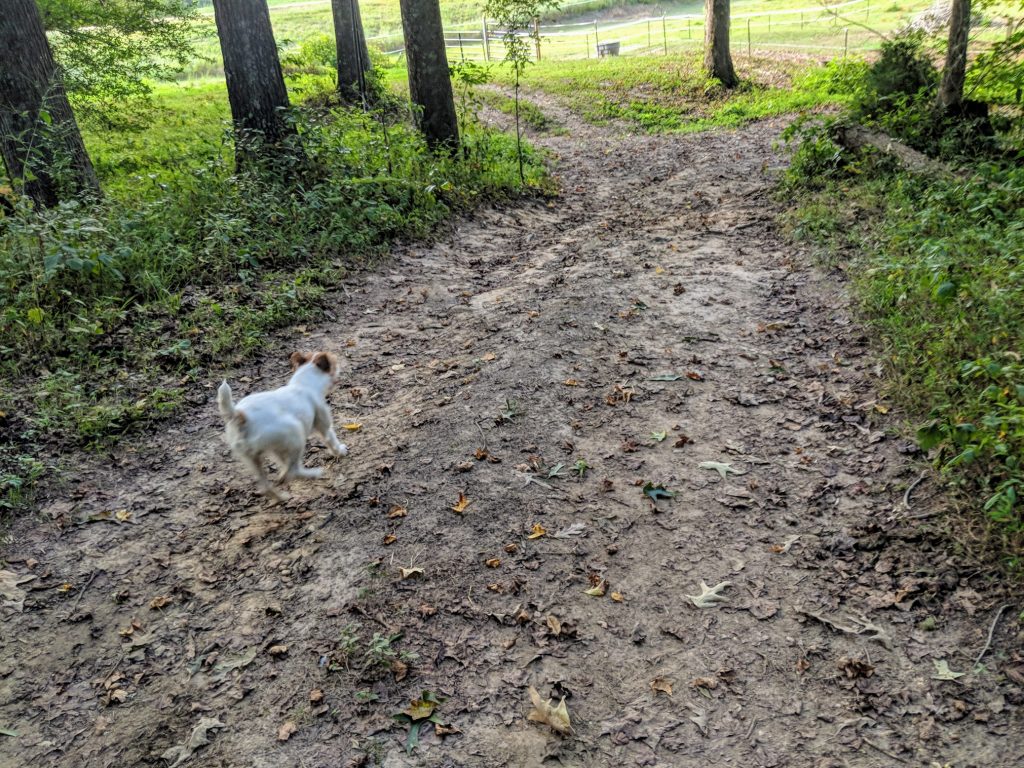
Just a happy terrier walking down the trail with all the sounds and sights of the farm at hand.
It can be quiet in the country. It can also be quite loud, such as when I start the Gator up to transport water to the ponies or the neighbor whizzes by in his horse drawn buggy. There may be a chainsaw next door, the honk from the UPS guy (they deliver everywhere) or in our case today, a limb snapping off a tree near us with an impressive crack and thud. Sure, not every sound we encounter is going to illicit a carefree and happy response, but the goal is for it not to end our day or interrupt our work more than it needs to. Liam isn’t a terribly confident dog, but he shook off the sound and we kept on about our business.
TEST 11: DOG APPROACHES LIVESTOCK
The handler, with the dog at side on a loose lead, enters a fenced area that contains livestock within a separate inside enclosure. The handler and the dog approach penned livestock, close enough so that the dog can clearly observe the stock. The dog can move ahead of the handler but cannot lunge or be held on a tight lead. The dog must remain responsive and under control while approaching livestock and/or if the dog’s presence causes the livestock to move within their enclosure. It is acceptable and anticipated that the dog may show interest and liveliness towards the livestock, but at no time should the dog exhibit fearfulness or aggressiveness. When instructed by the Judge, the handler will go to the end of the lead and recall the dog to the handler. The dog must comply and willingly return to the handler without tugging within two attempts. The dog must return attention to the handler and willingly exit the fenced area with the handler. All enclosure fencing must be in good condition, safe, and of a type that would not permit any passage by a dog, small or large. Skills Demonstrated: Demonstrates that the dog can exhibit self-control when asked to approach, and possibly move livestock, while on lead. Demonstrates the dog’s ability to be called away from livestock when instructed by the handler.
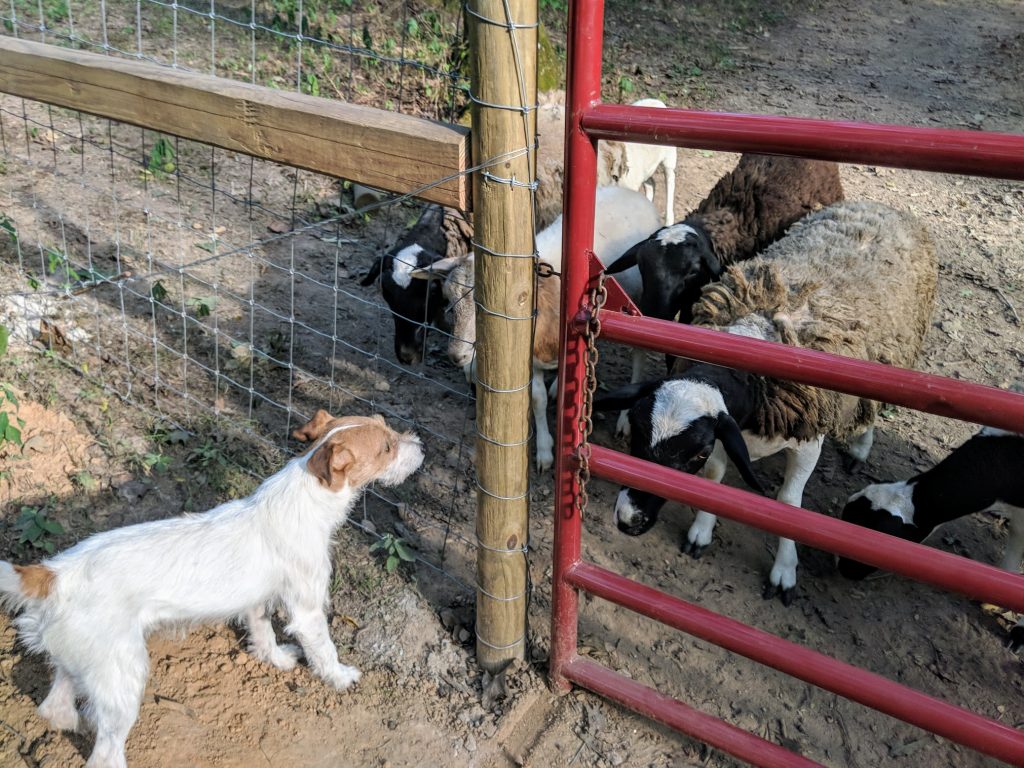
Side Story: I have always had farm dogs or been around farm dogs who just laid in the shade when we weren’t working. It’s what was expected and yet when I went on my first field excursion with Penelope, a Parson Russell Terrier, over a decade ago I was terrified she would get into mischief with the resident critters at the farmers we visited. Why? Because I had a terrier and terriers are supposed to be unruly beast creatures, right? Actually, that’s not true. AT ALL. My very first lesson was simple: If your dog harasses livestock or the resident dogs, we don’t get to come back and that is very likely the least of our problems. This means that even a prey driven working terrier needs to demonstrate manners, have a recall and not be a jack ass in general. Mind blown. It changed my perspective as a terrier person and made me a far better trainer.
Not long after I was at an earthdog trail where a competitor’s dog jumped into a pond chasing the resident geese. The exhibitor could not call the dog off the geese and did not pass, however, the individual made such a fuss that it wasn’t fair to expect a terrier to call off geese more than a hundred feet away that it was a significant issue for hosting there despite the fact that the other dogs worked right past the same distraction because that wasn’t the job.
Now, back to those farm chores…
While Liam and I were not out in the field today, his stock manners doing farm chores come from that work and experience. There isn’t a time when it is acceptable to chase horses or bark at sheep. Reinforcing recalls is a part of our every day life. It’s not something we practice now and again. It’s probably the most frequently reinforced behavior for my dogs. One of the things we specifically train for is a recall in the presence of other animals. These two things combined mean that while Liam is obviously interested in the sheep, he’s not harassing them and when I call, he comes with me. That’ll do, Liam. That’ll do.
TEST 12: PHYSICAL EXAMINATION
The handler examines the dog for any plant material, debris or objects that the dog may have collected while working on the farm. The handler may place the dog on a hay bale, table, or on the ground, and briefly examine the dog’s ears, eyes, mouth, coat and toes to ensure the dog is free of any foreign material such as grass, hay, burrs, etc. The dog must willingly accept the examination by the handler. Skills Demonstrated: Ability of the dog to exhibit patience, obedience, and trust in the handler while being touched and examined.
This isn’t just a Farm Dog skill, this is a life skill. Whether we’re running in the desert, working on the farm or just hanging out I am examining my dogs not only to look for things but to get a feel for what everything feels and looks like when it isn’t a crisis. The more we practice it calmly, the easier it is to handle a crisis or a less critical one like removing burrs from his coat. Liam wasn’t always thrilled about handling, but I’ve worked hard to make this as comfortable and safe as possible.
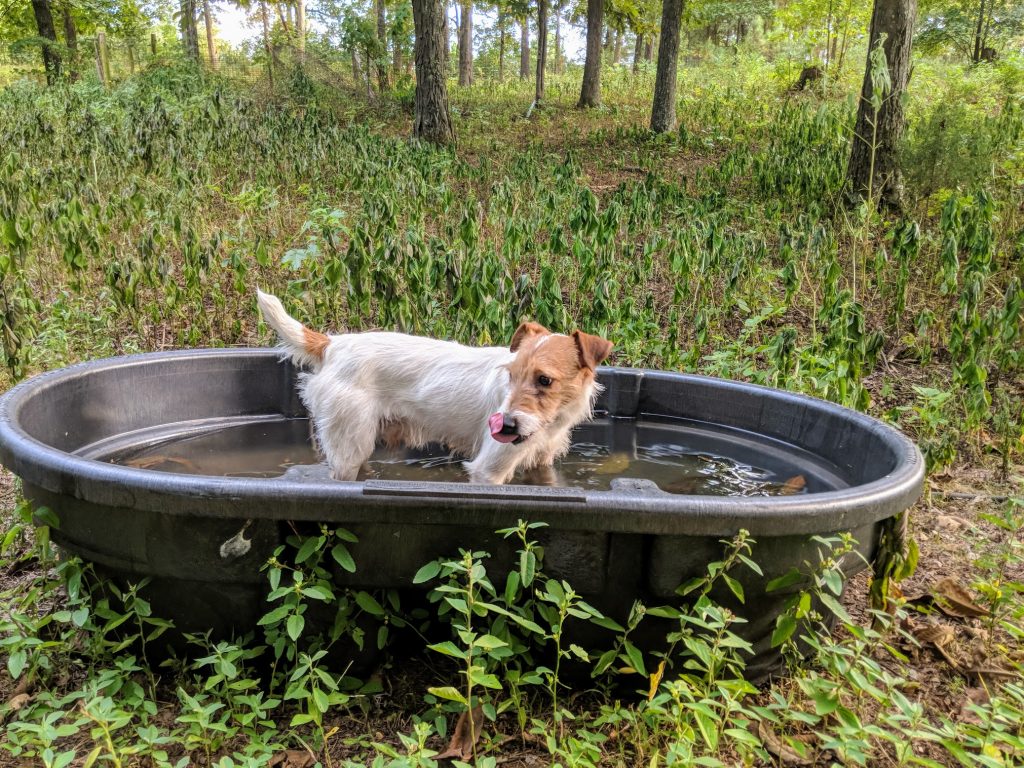
Cooling down at the end of the day.
Here’s what we learned today: The Farm Dog test is practical for not just dogs living on farms and ranches, but anyone who plans to visit or compete on a farm or ranch. Most importantly, it’s lovely to have a well-mannered dog welcome to visit such places with you.
For more information about the AKC Farm Dog Certified program, click here. And don’t forget! The Sierra Nevada Scent Work Club is hosting a Farm Dog Test in Reno, NV September 9, 2018! Click here for more information!
